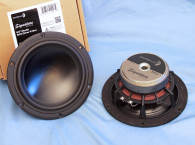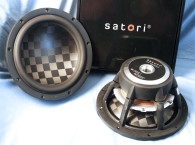
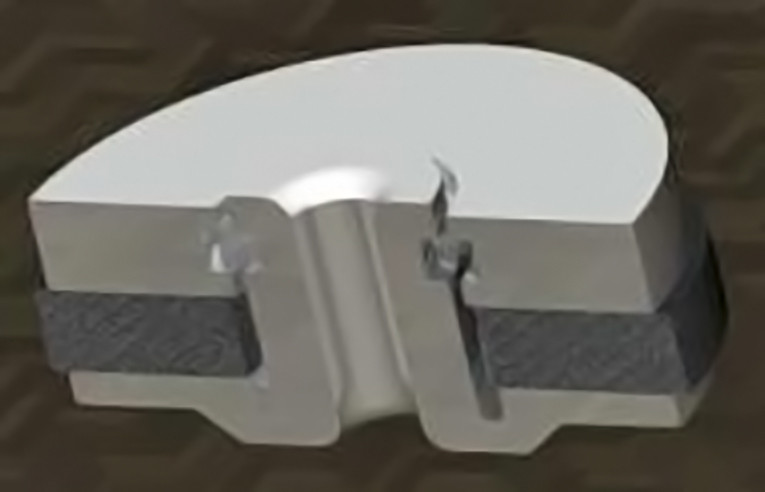
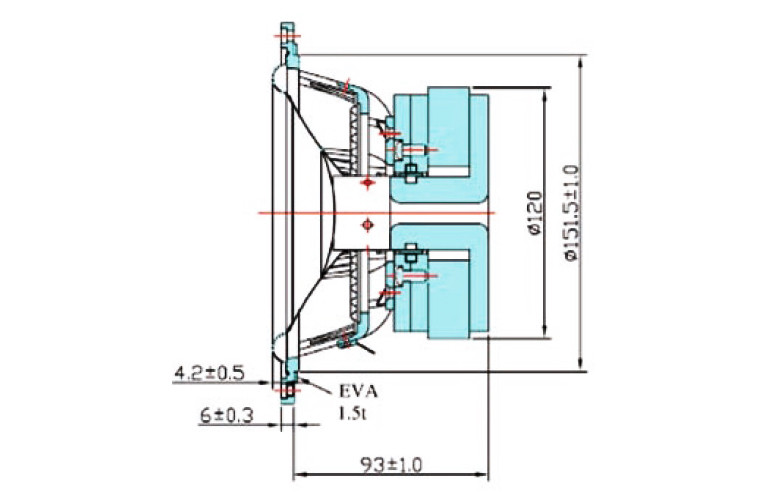
Exodus Audio is the www.diycable.com e-tailer’s loudspeaker label for their series of retail and OEM XBL dual gap woofers. Like the Audience 3″ woofer featured in the May 2009 issue of Voice Coil, Exodus Audio licenses the patented XBL motor configuration from ADI (Acoustic Development International, www.acousticdev.com), and patents from Dan Wiggens group (formerly Adire).
If you are not familiar with the XBL motor structure, Fig. 1 gives a cutaway photograph of an XBL motor, which is a dual gap design using a single shaped front plate. In the case of the Exodus Anarchy woofer, two plates are sandwiched together to get the same effect, along with a CNC groove in the pole piece which resembles a T-pole configuration. Figure 2 illustrates the W06017R woofer cutaway diagram.
The Exodus 6.5″ uses a very nice cast eight spoke aluminum frame that is almost completely open below the spider-mounting shelf for cooling. Additional cooling and pneumatic relief is provided by an 11mm diameter pole vent. The Anarchy cone is an anodized black aluminum alloy curvilinear design combined with a 2.31″ diameter anodized black aluminum concave dust cap, which together produce a very stiff 6.5″ cone. Compliance is provided by a black NBR (rubber) surround and a 4″ diameter flat cloth spider.
The motor for the W06017R consists of a 120mm × 12mm ferrite magnet sandwiched between a T-yoke and the dual front plate configuration. Driving the cone assembly is a 34.95mm diameter voice coil using a Kapton former wound with round CCAW wire and terminated to a pair of solderable terminals.
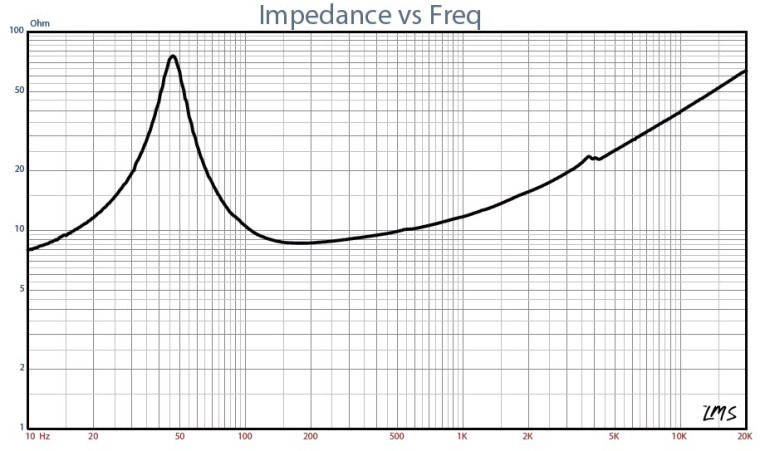

Setting up the initial test protocol, I clamped the driver to a rigid test fixture in free-air, and then generated both voltage and admittance (current) curves at 0.3V, 1V, 3V, 6V, 10V, 15V, and 20V. The 20V curves were somewhat too nonlinear for LEAP 5 to get an adequate curve fit, so I discarded them. I post-processed the remaining 12 10Hz-20kHz 550-point stepped sine wave curve pairs for each driver and divided the voltage curves by the current curves to produce the six impedance curves. The impedance curves each had the LMS phase calculation procedure applied and, along with the voltage curve for each sweep, imported to the LEAP 5 Enclosure Shop CAD program.
I additionally produced a LEAP 4 TSL model using the 1V free-air curves. I selected the complete curve set, the multiple voltage impedance curves for the LTD model (see Fig. 3 for the 1V free-air impedance curve) and the 1V impedance curves for the TSL model in the transducer derivation menu in LEAP 5, and produced the parameters for the computer box simulations. Table 1 compares the LEAP 5 LTD and TSL data and factory parameters for both W06017R Anarchy samples.
Thiele/Small LTD parameter results for the Exodus 6.5″ woofer were very close to the factory data, which is always gratifying. Given this, I proceeded to program computer enclosure simulations using the LEAP LTD parameters for Sample 1 using the sealed and vented enclosure volumes suggested by the LEAP 5 Quick Design menu. This included a 0.221ft3 closed box with 50% fiberglass fill material, and a 0.48ft3 Chebychev / Butterworth vented box alignment with 15% fiberglass fill material and tuned to 40Hz.
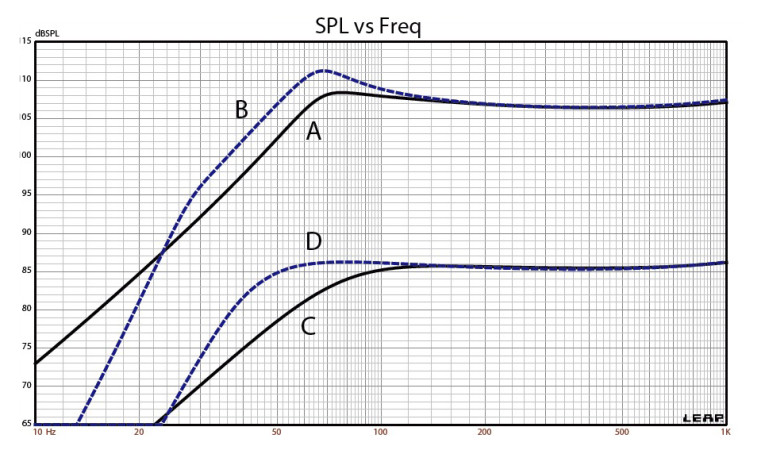
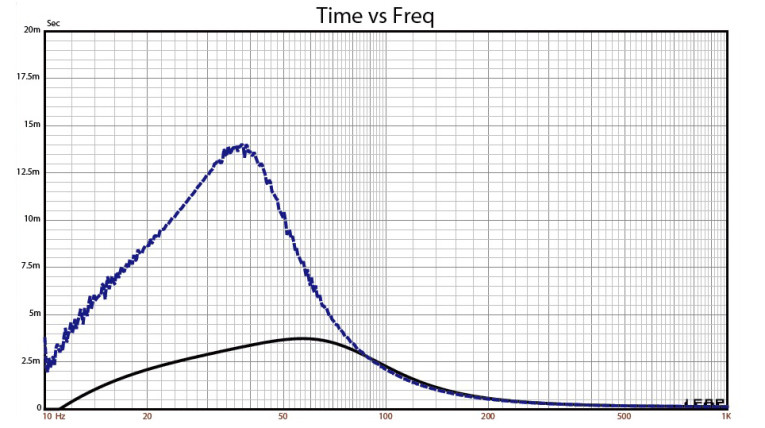
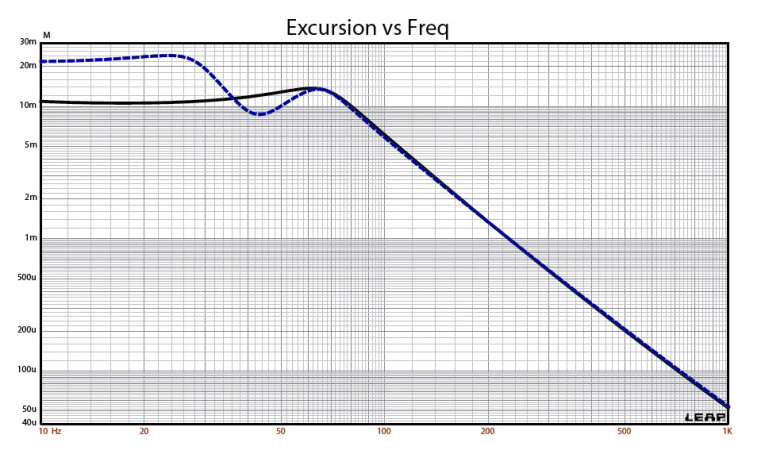
Figure 4 depicts the results for the Exodus Audio woofer in the sealed and vented boxes at 2.83V and at a voltage level high enough to increase cone excursion to Xmax + 15% (13.8mm for the W06017R). This calculation resulted in a F3 frequency of 68.8Hz with a Qtc = 0.7 for the 0.22ft3 sealed enclosure and -3dB = 44Hz for the 0.48ft3 vented box simulation. Increasing the voltage input to both simulations until the maximum linear cone excursion was reached resulted in 108.8dB at 46V for the smaller sealed enclosure and 111dB with a 50V input level for the larger vented box (see Fig. 5 and Fig. 6 for the 2.83V group delay curves and the 46/50V excursion curves). This is obviously a very high output driver for a 6.5″ because of the long excursion XBL motor.
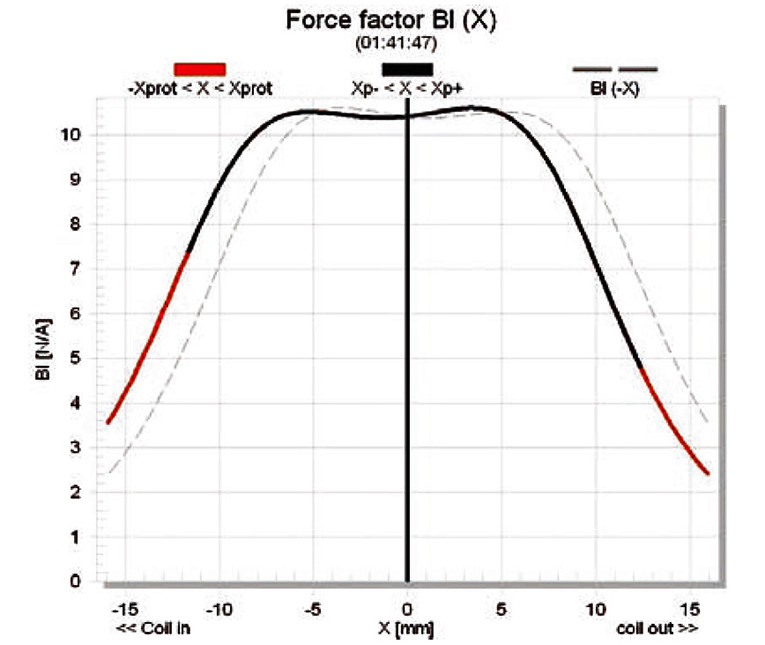
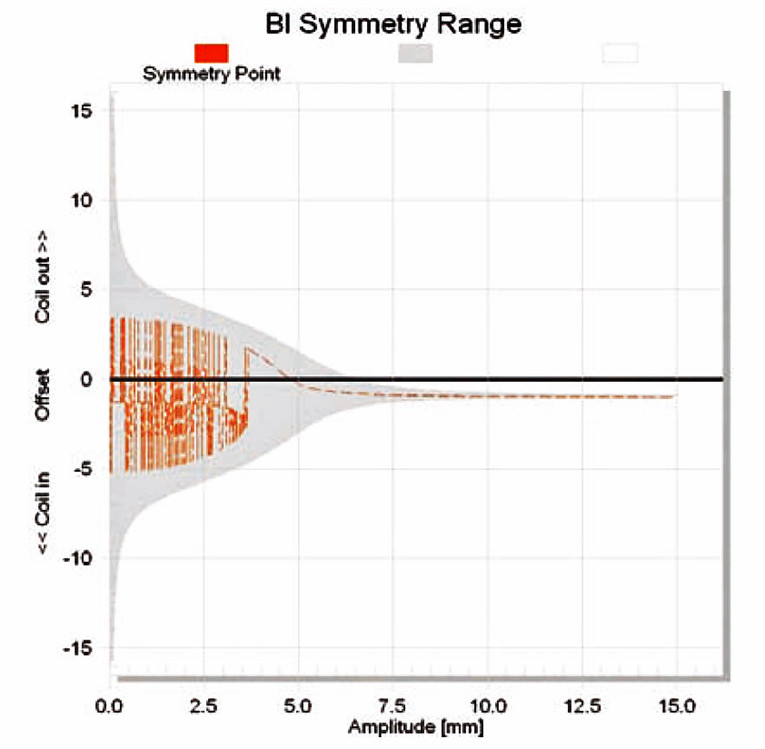
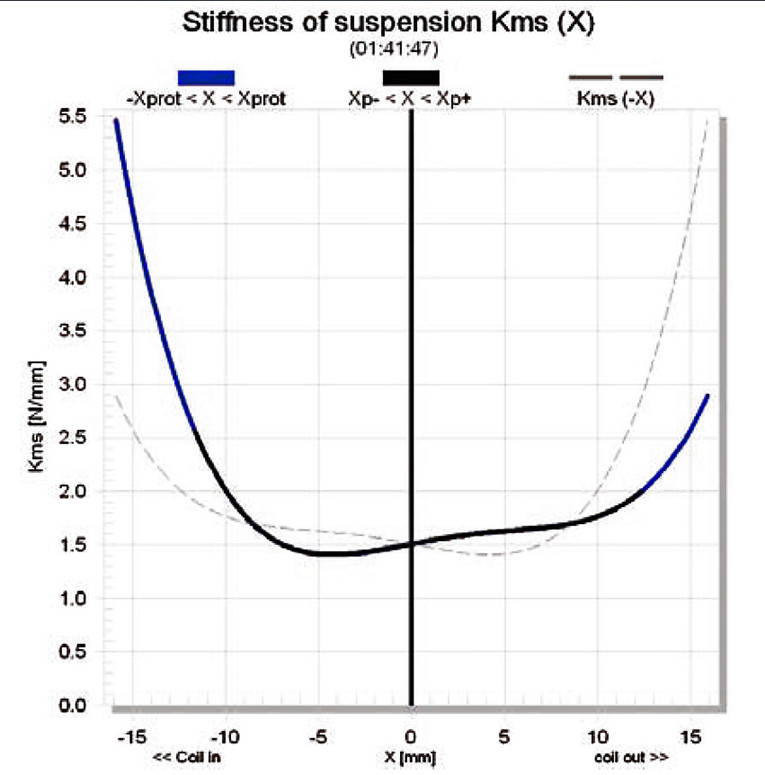
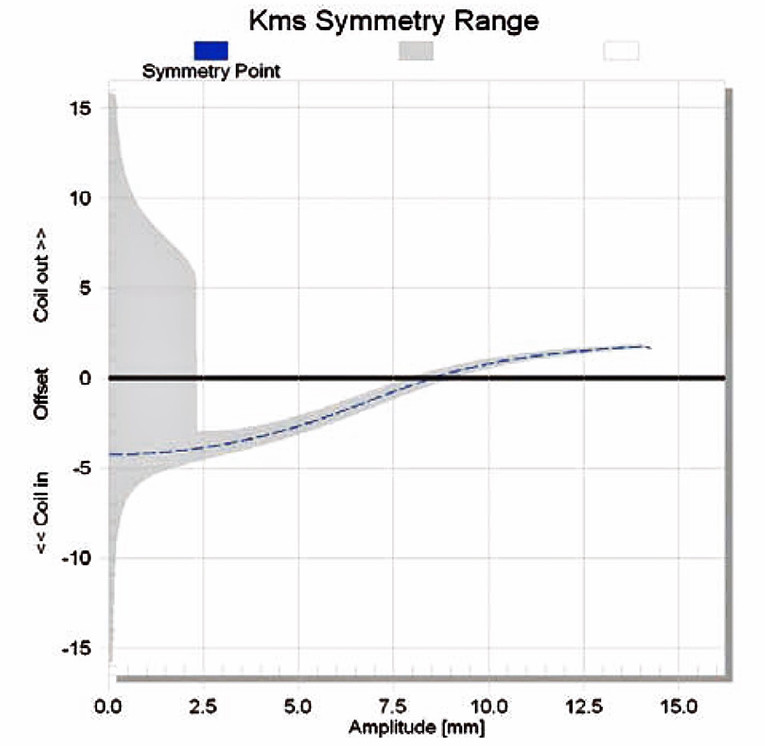
Klippel analysis for the Anarchy woofer produced the Bl(X), Kms(X) and Bl and Kms symmetry range plots given in Figs. 7-10. As you would expect for a long Xmax (12mm) driver, the Bl(X) curve (Fig. 7) is very flat and broad, and is very symmetrical with a small amount of coil-out offset. From the Bl symmetry plot (Fig. 8), Klippel could not resolve the curve close to the rest position; however, from about 6mm and greater in excursion, the coil-in offset is a constant 1mm, perhaps suggesting that the coil on this sample was set about 1mm away from magnetic center. Figures 9 and 10 give the Kms(X) and Kms symmetry range curves for the 6.5″ woofer. The Kms(X) curve is tilted and asymmetrical.
In the Kms symmetry range curve, there is a 4mm coil-in offset at rest decreasing to zero at 8.3mm, then transitions to a coil-out offset of 1.6mm at the physical Xmax of the driver. Displacement limiting numbers calculated by the Klippel analyzer for the W06017R were XBl at 82%, Bl = 8.5mm, and for XC at 75%, Cms minimum was 10mm, which means that the Bl is the most limiting factor at the prescribed distortion level of 10%. Figure 11 gives the inductance curves Le(X) for the Exodus Audio woofer. Inductance will typically increase in the rear direction from the zero rest position as the voice coil covers more pole area, which is what you see with the W06017R. From Xmax out to Xmax in, the inductance range is 0.68mH to 1.14mH, which is only about 0.46mH variance.

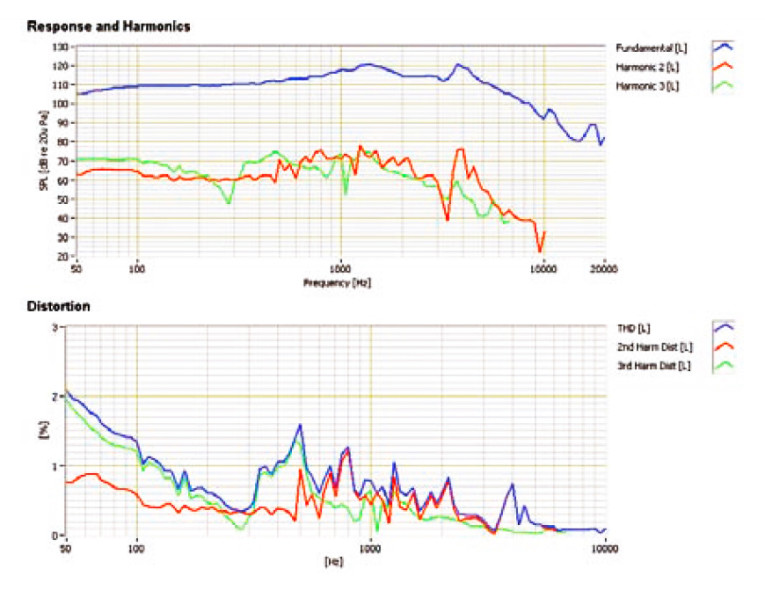
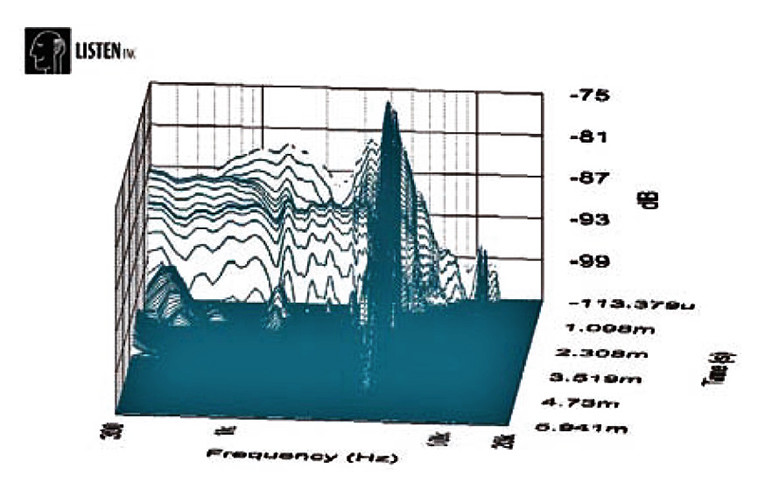

Next I fired up the Listen Inc. SoundCheck analyzer and set it up for distortion measurements. The SPL at 1m with the 6.5″ Exodus woofer mounted in free-air using pink noise was set to 94dB, my standard for home audio products. The W06017R produced the distortion curves shown in Fig. 12. Following the distortion measurements, I mounted the Anarchy woofer in an enclosure and made the impulse measurement. I imported this into Listen Inc.’s SoundMap software, windowed to remove the room reflections and produced the CSD waterfall plot in Fig. 13 and the Wigner-Ville plot in Fig. 14.
For the remaining series of SPL measurements, I measured the driver frequency response both on- and off-axis from 300Hz to 20kHz with a 100-point resolution at 2.83V/1m using a gated sine wave method. Figure 15 depicts the Exodus 6.5″ on-axis response, yielding a very smooth rising response out to 1.4kHz, which was followed by a 3dB decrease in SPL until a breakup mode at 4kHz.
Figure 16 illustrates the off-axis frequency response at 0, 15, 30, and 45°. -3dB at 30° with respect to the on-axis curve occurs at 3kHz, which is in the vicinity of the typical 3kHz or lower crossover frequency frequently used for 6.5″ drivers. And last, Fig. 17 gives the two-sample SPL comparisons for the Exodus Audio 6.5″ driver, showing both samples very closely matched. Exodus appears to have done a nice job producing a high output 6.5″ woofer for two-way applications.
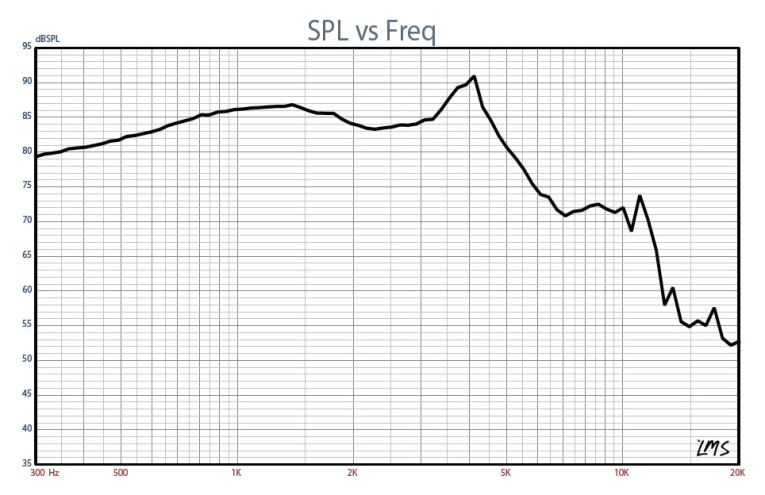
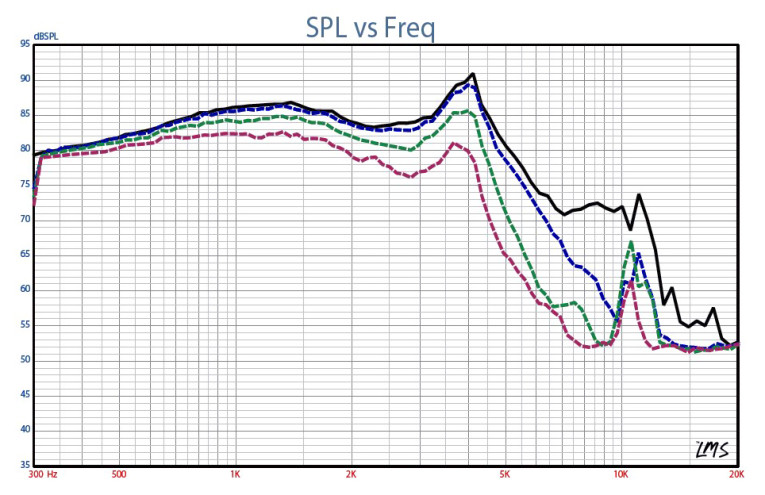

This article was originally published in Voice Coil, March 2010.




